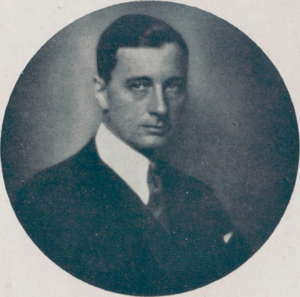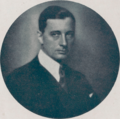Jacques Feyder facts for kids
Quick facts for kids
Jacques Feyder
|
|
|---|---|
 |
|
| Born |
Jacques Léon Louis Frédérix
21 July 1885 Ixelles, Belgium
|
| Died | 24 May 1948 (aged 62) Prangins, Switzerland
|
| Spouse(s) | Françoise Rosay (1917–1948, his death) |
Jacques Feyder (born 21 July 1885 – died 24 May 1948) was a famous Belgian film director, screenwriter, and actor. He mostly worked in France, but also in the United States, Britain, and Germany. He was known for directing silent films in the 1920s. Later, in the 1930s, he became linked with a film style called poetic realism in French cinema. He became a French citizen in 1928.
Contents
Jacques Feyder's Early Life and Film Career
Jacques Feyder was born as Jacques Léon Louis Frédérix in Ixelles, Belgium. He went to a military school and was expected to have a career in the army. However, when he was 25, he moved to Paris. There, he became interested in acting, first on stage and then in movies. He changed his name to Jacques Feyder.
He joined the Gaumont Film Company, a big film studio. In 1914, he started as an assistant director. By 1916, he was directing his own films. But his work was paused when he served in the Belgian army from 1917 to 1919.
After World War I, Feyder returned to making movies. He quickly became known as one of the most creative directors in French cinema. His first big films were L'Atlantide (1921) and Crainquebille (1922). These movies were popular with both the public and critics. He then made Visages d'enfants (1925), which was a very personal film for him.
Feyder was offered a job in Vienna as an artistic director for a new film company. He made one film there, Das Bildnis (1923). But the company failed, so he went back to Paris. He continued to make successful films like Gribiche (1926) and Carmen (1926). His last silent film in France was Les Nouveaux Messieurs (1929). This movie was a political comedy that caused some debate.
Working in Hollywood and Return to France
Around 1929, Jacques Feyder moved to Hollywood to work for MGM. His first project there was directing Greta Garbo in The Kiss. This was Garbo's last silent film. In Hollywood, Feyder started making sound films. He believed that sound films were the future, even when some other French directors were not sure about them. He also directed foreign-language versions of American films, like a German version of Anna Christie with Greta Garbo.
Feyder did not enjoy the Hollywood film system very much. So, he returned to France in 1933. Over the next three years, he made some of his most famous films. He often worked with screenwriter Charles Spaak and his wife, actress Françoise Rosay. Films like Le Grand Jeu (1934) and Pension Mimosas (1935) were important examples of poetic realism. His film La Kermesse héroïque (1935) was a detailed historical film that won several international awards.
Before World War II began, Feyder directed films in England and Germany. But these films were not as successful. When the Nazis occupied France in 1940, his film La Kermesse héroïque was banned. Feyder then moved to Switzerland for safety. There, he directed his last film, Une femme disparaît (1942).
In 1917, Jacques Feyder married the actress Françoise Rosay. They had three sons. Françoise Rosay acted in many of his films. She also helped him write and direct Visages d'enfants. Jacques Feyder passed away in 1948 in Prangins, Switzerland. A school in Épinay-sur-Seine, France, was named after him in 1977.
Jacques Feyder's Film Style and Legacy
Jacques Feyder saw himself as a "craftsman" of filmmaking. This means he focused on the technical skills and artistry of making movies. He wanted to be creatively independent. This is why he made films in many different countries, choosing where the conditions were best.
Some common themes in his movies include:
- A strong love for a mysterious woman, seen in films like L'Atlantide and Carmen.
- The difference between what people imagine and what is real, shown in Crainquebille and La Kermesse héroïque.
- The strong love of a mother, found in Gribiche and Pension Mimosas.
His films were known for being balanced and clear. The way he composed his shots was beautiful but also natural. He also had a good connection with his actors. Most importantly, his films felt very real. He achieved this by adding careful details, filming in real locations, and using well-designed sets. He often worked closely with set designer Lazare Meerson.
Feyder's focus on realism was different from some other directors of the 1920s. His style helped lead to the popular film movement called poetic realism. This style was later fully developed by directors like Marcel Carné, who worked as Feyder's assistant in the 1930s.
After his death, interest in Feyder's films faded a bit. Some important film critics in the 1950s were not very positive about his work. However, other directors, like René Clair, believed that Feyder deserved more recognition. Today, it can be hard to find some of his films, especially in English-speaking countries. This has made it harder for people to fully appreciate all his work.
Filmography
- 1915: Des pieds et des mains (assistant director)
- 1916: Monsieur Pinson policier
- 1916: Le Bluff
- 1916: Le Pied qui étreint
- 1916: Biscot se trompe d'étage
- 1916: Têtes de femmes, femmes de tête
- 1916: Un conseil d'ami
- 1916: L'Homme de compagnie
- 1916: Tiens, vous êtes à Poitiers?
- 1916: Le Frère de lait
- 1916: La Pièce de dix sous
- 1917: L'Instinct est maître
- 1917: Le Billard cassé
- 1917: Le Pardessus de demi-saison
- 1917: Abrégeons les formalités
- 1917: La Trouvaille de Buchu
- 1917: Les Vieilles Femmes de l'hospice
- 1917: Le Ravin sans fond (co-director)
- 1919: La Faute d'orthographe
- 1921: L'Atlantide
- 1922: Crainquebille
- 1923: Das Bildnis (L'Image/The Portrait)
- 1925: Visages d'enfants
- 1926: Gribiche
- 1926: Carmen
- 1926: Au pays du roi lépreux (uncompleted)
- 1928: Thérèse Raquin
- 1929: Les Nouveaux Messieurs
- 1929: The Kiss
- 1930: Le Spectre vert
- 1930: Si l'empereur savait ça
- 1930: Olympia (German version of Si l'empereur savait ça)
- 1930: Anna Christie (German version)
- 1931: Daybreak
- 1931: Son of India
- 1934: Le Grand Jeu
- 1935: Pension Mimosas
- 1935: La Kermesse héroïque
- 1936: Die Klugen Frauen (German version of La Kermesse héroïque)
- 1937: Knight Without Armour
- 1938: Les Gens du voyage (People Who Travel)
- 1938: Fahrendes Volk (German version of Les Gens du voyage) (Travelling People)
- 1939: La Loi du nord
- 1942: Une femme disparaît
- 1946: Macadam (supervision only)
Images for kids
See also
 In Spanish: Jacques Feyder para niños
In Spanish: Jacques Feyder para niños



